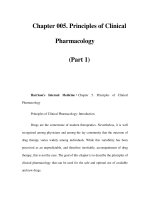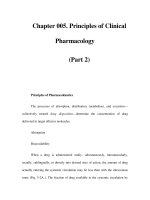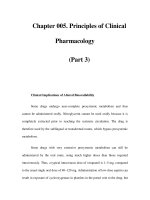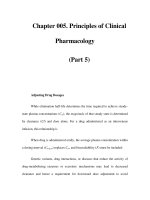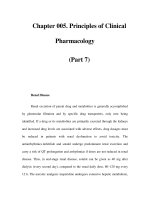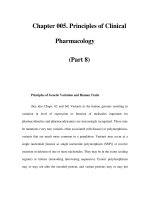Chapter 081. Principles of Cancer Treatment (Part 9) pdf
Bạn đang xem bản rút gọn của tài liệu. Xem và tải ngay bản đầy đủ của tài liệu tại đây (42.09 KB, 5 trang )
Chapter 081. Principles of
Cancer Treatment
(Part 9)
Following demonstration of activity in animal models, conventional
chemotherapeutic agents are further evaluated to define an optimal schedule of
administration and arrive at a drug formulation designed for a given route and
schedule. Safety testing in two species on an analogous schedule of administration
defines the starting dose for a phase I trial in humans. This is established as a
fraction, usually one-sixth to one-tenth, of the dose just causing easily reversible
toxicity in the more sensitive animal species. Escalating doses of the drug are then
given during the human phase I trial until reversible toxicity is observed. Dose-
limiting toxicity (DLT) defines a dose that conveys greater toxicity than would be
acceptable in routine practice, allowing definition of a lower maximal tolerated
dose (MTD). The occurrence of toxicity is, if possible, correlated with plasma
drug concentrations. The MTD or a dose just lower than the MTD is usually the
dose suitable for phase II trials, where a fixed dose is administered to a relatively
homogeneous set of patients with a particular tumor type in an effort to define
whether the drug causes regression of tumors. An "active" agent conventionally
has PR rates of at least 20–25% with reversible non-life-threatening side effects,
and it may then be suitable for study in phase III trials to assess efficacy in
comparison to standard or no therapy.
Response, defined as tumor shrinkage, is but the most immediate indicator
of drug effect. To be clinically valuable, responses must translate into clinical
benefit. This is conventionally established by a beneficial effect on overall
survival, or at least an increased time to further progression of disease. Active
efforts are being made to quantitate effects of anticancer agents on quality of life.
Cancer drug clinical trials conventionally use a toxicity grading scale where grade
I toxicities do not require treatment, grade II often require symptomatic treatment
but are not life-threatening, grade III toxicities are potentially life-threatening if
untreated, grade IV toxicities are actually life-threatening, and grade V toxicities
are those that result in the patient's death.
Development of targeted agents should proceed quite differently. While
Phase I–III trials are still conducted, molecular analysis of human tumors more
precisely defines targets expressed in a patient's tumor and should allow patient
selection to enrich all trial phases with patients potentially responsive to the agent
by virtue of expressing the target in the tumor. Clinical trials may be designed that
assess the behavior of the drug in relation to its target. Ideally, the plasma
concentration that affects the drug target is known, so escalation to MTD may not
be necessary. Rather, the correlation of host toxicity while achieving an "optimal
biologic dose" becomes a more relevant endpoint for Phase I and early Phase II
trials with targeted agents.
Valuable cancer drug treatment strategies using conventional chemotherapy
agents, targeted agents, hormonal treatments, or biologicals have one of two
valuable outcomes. They can induce cancer cell death, resulting in tumor
shrinkage with corresponding improvement in patient survival, or increase the
time until the disease progresses. Another potential outcome is to induce cancer
cell differentiation or dormancy with loss of tumor cell replicative potential and
reacquisition of phenotypic properties resembling normal cells. Blocking tumor
cell differentiation may be a key feature in the pathogenesis of certain leukemias.
Cell death is a closely regulated process. Necrosis refers to cell death
induced, for example, by physical damage with the hallmarks of cell swelling and
membrane disruption. Apoptosis, or programmed cell death, refers to a highly
ordered process whereby cells respond to defined stimuli by dying, and it
recapitulates the necessary cell death observed during the ontogeny of the
organism. Anoikis refers to the death of epithelial cells after removal from the
normal milieu of substrate, particularly from cell-to-cell contact. Cancer
chemotherapeutic agents can cause both necrosis and apoptosis. Apoptosis is
characterized by chromatin condensation (giving rise to "apoptotic bodies"); cell
shrinkage; and, in living animals, phagocytosis by surrounding stromal cells
without evidence of inflammation. This process is regulated either by signal
transduction systems that promote a cell's demise after a certain level of insult is
achieved, or in response to specific cell-surface receptors that mediate cell death
signals. Modulation of apoptosis by manipulation of signal transduction pathways
has emerged as a basis for understanding the actions of drugs and designing new
strategies to improve their use.
A general view of how cancer treatments work is that the interaction of a
chemotherapeutic drug with its target induces a "cascade" of further signaling
steps. These signals ultimately lead to cell death by triggering an "execution
phase" where proteases, nucleases, and endogenous regulators of the cell death
pathway are activated (Fig. 81-3).
Figure 81-3


